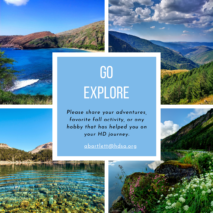Disabled Not Unable: Getting Outside
So much of this disability blog is about how to prepare for the future through disability planning, financial planning, and legal planning. These are all very serious topics that can be mentally and emotionally draining. To celebrate my personal favorite season, the fall, I want to take a few weeks to enjoy the here and now.
As the Senior Manager of HDSA’s Disability Program, it is very easy for me to get wrapped up in the disability process and disability advocacy. But I want to use this blog to remind everyone that Disabled does not mean Unable. Life may look different, but it is still beautiful with so many adventures to enjoy.
Some fun fall activities that are accessible for the entire family include nature walks, hiking, camping, and a scenic drive to view fall foliage. (No, I was not influenced by MaryAnn Emerick, I love these activities too.) The best part of these activities is that most of them can be done for free through the Access Pass Program for disabled individuals.
National Parks Access Pass
The National Parks Access Pass provides US citizens and permanent residents with a permanent disability free entrance to All national parks. The Access pass also grants entrance to more than 2,000 recreation sites managed by:
- Bureau of Land Management
- Bureau of Reclamation
- Fish and Wildlife
- USDA Forest Service
- National Park Service
- US Corps of Engineers
The pass can also be used to get discounts on camping, swimming, boat launching, and guided tours.
There is no age limit or requirement for the Access Pass. You can prove you are permanently disabled a variety of ways, including:
- A statement by a licensed physician – the statement must include that you have a permanent disability that limits one or more aspects of your daily life, and the nature of those limitations;
- Documents issued by a federal agency such as Social Security or the Veteran’s Administration;
- Documents issued by a state agency like vocational rehabilitation.
You can see examples of proper documentation here.
You can get the Access Pass in person at a federal recreation site. Passes are not available at all national park sites so make sure to check availability before you go. You can also get a pass online, there is a $10 processing and mailing fee if you get the pass online.
Start Parks Access Pass
Many state parks also offer discounted admissions, fees, or passes for people with disabilities. You can find information on all 50 state programs and discounts here.

Planning a Visit
When planning a park visit, make sure to look at all of the accessibility options. The parks offer things like interpreters, mobility equipment, wheelchairs, and accessible camping sites. Each park has different accessibility offerings so make sure to check what is available with the park you want to visit. All parks list their accessibility options through the “Plan Your Visit” tab, or you can find information here.
What do you love to do?
The next few weeks this blog will cover fun family activities and discounts for disabled individuals and their families. I would love to know, what are some of your favorite activities? Then, with your permission of course, I would love to include family stories in an October blog post. It is so important for us to celebrate the fun activities and the joys in life.
Getting back to National Parks for now, my favorite is Shenandoah National Park. I even did the hardest hike in the park, Old Rag, while pregnant! I don’t know if I recommend that, but there are some beautiful waterfall hikes. MaryAnn’s favorite National Park is Yosemite. What is yours?
Contact Us
If you have questions, you can always Ask Allison!

